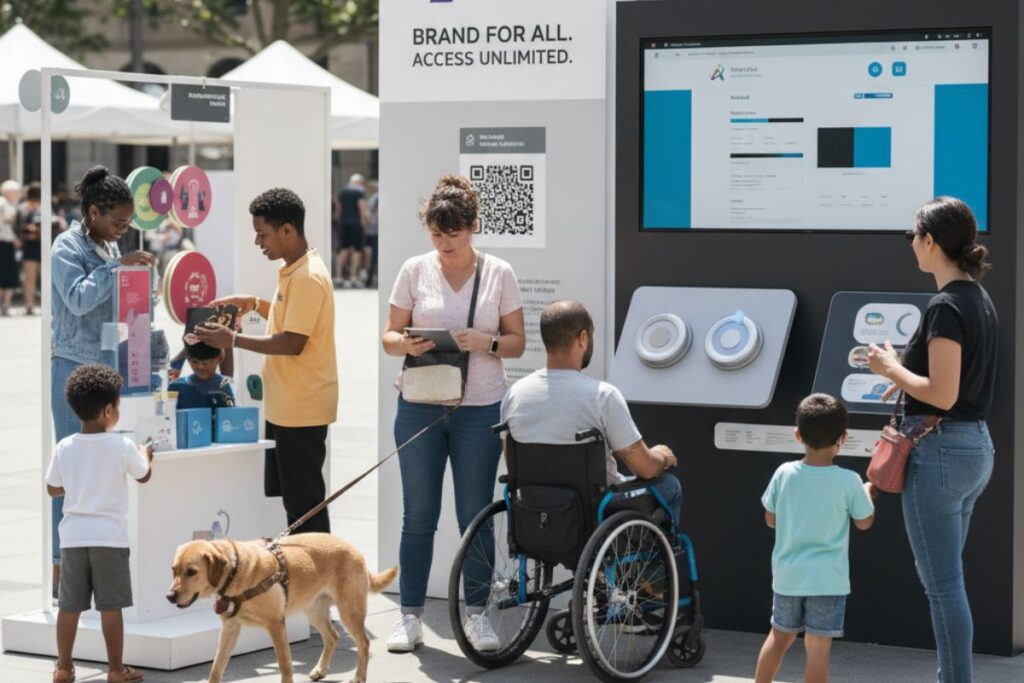Brand accessibility has become essential for modern businesses that want to reach wider audiences, improve user experience, and build long-term trust. In today’s digital world—where websites, social media, apps, and online services shape customer behavior—ensuring everyone can access your brand’s content is a vital part of ethical, inclusive, and sustainable marketing. This includes people with disabilities, older adults, neuro divergent users, and individuals facing temporary limitations.
Brand accessibility connects directly to related entities such as WCAG (Web Content Accessibility Guidelines), ADA compliance, inclusive design, universal design, UX design, assistive technologies, digital inclusivity, and user-centered design. These concepts work together to create digital environments that everyone can use, understand, and engage with.
This guide explains what brand accessibility is, why it matters, and how businesses can apply accessibility principles to improve digital presence. It also includes practical steps, examples, and FAQs for better understanding.
What Is Brand Accessibility?
Brand accessibility means designing your digital and physical brand experiences so everyone can interact with them without barriers. It goes beyond compliance and focuses on creating fair, inclusive, and meaningful experiences for all users.
In simple terms, brand accessibility ensures:
-
People with disabilities can use your website, app, or content
-
Content is readable, understandable, and easy to navigate
-
Products and services are usable across different devices and assistive technologies
-
All users feel valued and included
Brand accessibility also includes making sure that areas like customer service, social media communication, visual design, and brand identity work well for users with diverse needs.
Why Brand Accessibility Matters
Accessibility is no longer optional. It is a business necessity, social responsibility, and strategic advantage. Here are the core reasons:
1. It Improves User Experience for Everyone
Accessible design benefits all users—not just those with disabilities. For example:
-
Clear text helps people with low vision and improves readability for all
-
Video captions help deaf users and people watching silently
-
Easy navigation supports users with motor disabilities and mobile users
2. It Expands Your Brand’s Reach
Over 1.3 billion people worldwide live with some form of disability. When brands ignore accessibility, they miss a massive market segment.
3. It Strengthens Brand Reputation
Accessible brands are seen as socially responsible, ethical, and customer-centric. This improves trust, emotional connection, and long-term loyalty.
4. It Helps with ADA & WCAG Compliance
Brand accessibility supports:
-
ADA (Americans with Disabilities Act) compliance
-
WCAG 2.1 and 2.2 guidelines
-
Local accessibility laws
Non-compliance can lead to lawsuits, penalties, and damaged brand reputation.
Core Components of Brand Accessibility
To build an accessible brand, businesses must focus on the following areas:
1. Accessible Website & Digital Platforms
Your website must support:
-
Keyboard navigation
-
Screen readers
-
Clear color contrast
-
Readable fonts
-
Alt text for images
-
Logical heading structure
-
Accessible forms
2. Accessible Content
Your content should be simple, clear, and understandable:
-
Short paragraphs
-
Plain language
-
Descriptive links
-
Captioned videos
-
Transcripts for audio
3. Inclusive Visual Design
Visual elements should avoid unnecessary complexity. Good practices include:
-
High contrast ratios
-
Color-blind friendly palettes
-
Resizable text
-
Consistent layout patterns
4. Accessible Social Media
Social media accessibility includes:
-
Alt text for images
-
Hashtags in Pascal Case (#BrandAccessibility)
-
Captioned videos
-
Descriptive visuals
5. Accessible Customer Support
This includes:
-
Live chat
-
Voice and text support
-
Accessible chatbots
-
Clear instructions and FAQs
6. Inclusive Product & Service Design
This applies accessibility principles to all brand touchpoints—from apps to packaging to physical stores.
How to Build an Accessible Brand
Below are actionable steps to create a strong accessibility strategy:
1. Audit Your Current Accessibility
Use tools such as:
-
WAVE
-
Lighthouse
-
AXE
-
WCAG checklists
These help identify gaps.
2. Follow WCAG Guidelines
Aim for at least WCAG 2.1 AA compliance.
Focus on:
-
Perceivable
-
Operable
-
Understandable
-
Robust content
3. Use Inclusive Language
Avoid biased, disrespectful, or confusing terms. Write clearly and respectfully.
4. Train Your Team
Your designers, marketers, developers, and writers must understand accessibility principles.
5. Test with Real Users
User testing with people with disabilities ensures real-world accessibility.
6. Build Accessibility Into Your Brand Guidelines
Your style guide should include:
-
Color contrast rules
-
Alt text standards
-
Typography rules
-
Accessible layout patterns
7. Make Accessibility a Continuous Commitment
Accessibility is not a one-time task. It requires updates, evaluation, and improvement.
Conclusion: Brand Accessibility Is a Promise of Inclusion
Brand accessibility is not just a technical requirement—it is a commitment to inclusivity, respect, and equal opportunity. By embracing accessible design, inclusive branding, and universal user experience principles, businesses can improve usability, connect with diverse audiences, and build a brand that truly represents everyone.
Making your brand accessible helps you grow, strengthen trust, stay compliant, and show your customers that you value every individual. Start building your accessibility roadmap today, and let your brand become a symbol of inclusivity and positive change.
FAQs
What is the main goal of brand accessibility?
The goal is to create a brand experience that everyone can use and understand, without barriers.
Does brand accessibility help with SEO?
Yes. Accessible content improves SEO, user engagement, and AI-driven rankings.
Who benefits from accessible brands?
People with disabilities, older adults, multilingual users, mobile users, and every customer interacting with your brand.
Is accessibility required by law?
In many countries, yes. Laws like ADA and EN 301 549 mandate accessible digital content.
How can small businesses improve accessibility?
Start with simple steps: add alt text, use readable fonts, improve contrast, and caption videos.



